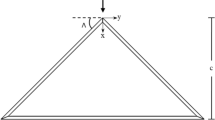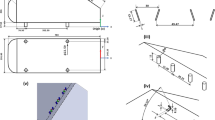Abstract
The authors designed three different front profiles for supercavitating vehicles based on cavity theory and the Granville streamlined equation are designed. Experiments were done using these front profiles in the Northwestern Polytechnical University high-speed water tunnel. The experiments indicated that the critical volume of gas required for supercavitation is affected by the axial distribution of the front-end’s slope. The experimental data showed critical gas flow rates required for the three designs were less than mod-1, with the greatest decrease 24%. The experimental results also showed the supercavitation generation speeds of the models were faster than mod-1 by up to 32.4%. This verifies that the front profile of a supercaviting vehicle effects supercavity generation speed and critical gas flow rates. The smaller the changes in axial distribution of pressure, the higher the supercavity generation speed. The smaller the changes in curvature distribution of axial, the smaller the critical gas flow rates.
摘 要
本文基于航行体超空泡理论和格兰威尔线型设计方法, 设计了三种具有不同前部线型的航行体模型. 并针对所设计的三种模型和具有锥形前部外型的航行体模型在西北工业大学水洞中进行了前部线形对超空泡生成影响的实验研究. 结果表明: 超空泡生成速度和空泡成生所需临界通气量与航行体的轴向斜率分布有关, 模型表面斜率轴向分布曲线越平坦或变化率越小, 越有利于提高空泡的生成速度. 减少超空泡生成所需的临界通气量. 实验数据显示文中设计的三种格兰威尔前部线型航行体与锥形前部外型航行体相比, 生成超空泡所需临界通气量都有明显减小, 空泡生成速度有明显提高. 文章研究方法为降低超高速航行体超空泡生成所需的临界通气量, 提高空泡的生成速度提供了一条技术途径和研究方法.
Similar content being viewed by others
References
SEMENENKO Vladimir. Artificial supercavitation. physics and calculation. RTO AVT/VKI special course: supercavitating flows, von Karman Institute for fluid dynamics[R]. Rhode-Saint-Genese, Belgium, 2001: 12–16.
WAID R L. Cavity shapes for circular disks at angles of aAttack[R]. CIT Hyd. Rpt. E-73. 4, 1957.
CHOI J H, PENMETSA R C, VGRANDHI R. Shape optimization of the cavitator for a supercavitating torpedo[J]. Struct Multidisc Optim, 2005, 29: 159–167.
JIA Liping, WANG Cong, YU Kaiping, et al. Experimental investigation of cavitator parameters[J]. Engineering Mechanics, 2007, 24(3): 159–164.
WANG Haibin, ZHANG Jiazhong, WEI Yingjie, et al. Study on relations between cavity form and typical cavitator parameters[J]. Journal of Hydrodynamics, 2005 20(2): 251–258.
ZHANG Yuwen. Cavity theory and application[M]. Xi’an: Northwestern Polytechnical University Press, 2007.
GRANVILLE P S. Geometrical characteristics of streamlined shapes[J]. Journal of Ship Rasearch, 1969, 13(4):.
Author information
Authors and Affiliations
Corresponding author
Additional information
Zhang Bo was born in 1979. He is a PhD candidate at Northwestern Polytechnical University, majoring in weapon firing theory and technology.
Zhang Yu-wen was born in July 1946. He is a professor and doctoral supervisor at Northwestern Polytechnical University, majoring in weapon system and expert engineering, firing theory and technology, trajectory and control, etc.
Yuan Xu-long was born in 1977. He is an instructor at Northwestern Polytechnical University, majoring in firing theory and technology, trajectory and control, etc.
Rights and permissions
About this article
Cite this article
Zhang, B., Zhang, Yw. & Yuan, Xl. Effects of the profile of a supercavitating vehicle’s front-end on supercavity generation. J. Marine. Sci. Appl. 8, 323–327 (2009). https://doi.org/10.1007/s11804-009-8070-8
Received:
Published:
Issue Date:
DOI: https://doi.org/10.1007/s11804-009-8070-8
Keywords
- cavitation
- supercavitating vehicle
- volumetric gas flow rate
- front profile
- supercavitation generation speed




